Games
PCB
Archive
Chip
Archive
Cart/Box
Scans
Articles
Peripherals
Prototypes
Unreleased
Games
Rarities
Homebrew
Emulation
Links
Email: snes_central@yahoo.ca
Super Metroid

| Game Code: | RI | Genre: | Action / Platform Adventure |
| US Title: | Super Metroid | US Publisher: | Nintendo |
| Japan Title: | Super Metroid | Japan Publisher: | Nintendo |
| Title in Kanji: | Title in Kana: | ||
| European Title: | Super Metroid | Europe Publisher: | Nintendo |
| Developer: | Nintendo | Players: | 1 |
| Accessories: | none | Special Chips: | none |
| Save: | Battery |
 Super Metroid is an action-adventure/platform game in which players control battle-hardened bounty hunter Samus Aran. She finds herself revisiting her adopted homeworld, Planet Zebes, after a distress call from Galactic Federation Space Station Ceres yields dreadful news: the Zebesian Space Pirates, once thought annihilated by Samus herself, are alive and thriving, under the leadership of Samus's great nemesis, Ridley. The third game in the venerated Metroid series, Super Metroid was developed by Nintendo's R&D1 division and first-party developer Intelligent Systems. Super Metroid was directed by Yoshio Sakamoto, who has since directed three subsequent Metroid games, and he is widely considered the father of the series. By:
Michael Burns
|
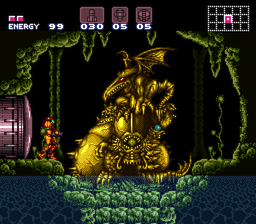 |
| Four Titans. |
No attempt to evaluate such a landmark game as Super Metroid would be complete without taking account of the larger affect it's had on video games and the way we play them. Consider that the entire sub-genre of open-ended platform gaming, if not necessarily pioneered by Sakamoto-san's freshman effort, was certainly perfected by it. It was originally dubbed "Metroidvania" by 1UP writer Scott Sharkey due to its initial reference to 'Castlevania games that play like Super Metroid'. The application of this sub-genre has since been widened to cover any 2D platform game that encourages completion through non-linear exploration of a large, undivided game map. While this rather ungainly term has been used to describe such revered classics as Castlevania: Symphony of the Night (Playstation), Shantae (Gameboy Color), Cave Story (PC/Wii Ware/DSi Ware), and Blaster Master (NES), no game has pulled it off quite so organically as Super Metroid. What does that mean, exactly? More on that shortly. Suffice to say, Super Metroid, which will be approaching its 20th birthday in just three short years, hasn't aged a day: it's the definitive example of this kind of game design, and that makes it, in my book, the greatest game ever made.
Story
"The last Metroid is in captivity. The galaxy is at peace."
At the end of Nintendo's 1991 Gameboy classic, Metroid II: Return Of Samus, our heroine, having just eradicated every last one of a parasitic race of jellyfish-like creatures known as Metroids, is en route to her gunship, which is waiting to fly her far away from SR388, the Metroid homeworld. To her surprise, she comes across one last Metroid egg. Before she has a chance to destroy it, a hatchling emerges from the egg - but rather than attempting to sap Samus of her life force (as is the Metroid's wont), it takes to her as its mother. Rather than destroying it, Samus chooses to temporarily adopt the baby, with the intention of dropping it off at a Galactic Federation research facility, Space Station Ceres, where it can be studied for potential scientific application. No sooner than Samus drops off the hatchling and departs from Ceres, she receives a distress call: the Space Station is under attack! Flipping a quick U-turn, Samus returns to Ceres to discover its entire live-in staff has been massacred at the hands of an unknown force. Unnerved by the total silence she is met with, Samus proceeds cautiously through Ceres, hoping to discover some clue to the scientists' fate. What she discovers is worse than anything she could've possibly imagined: Ridley, captain of the Zebesian Space Pirates, is back! When Samus confronts Ridley, the Metroid hatchling dangling from his hand, her attempts to subdue him are unsuccessful, and he flees the station. Facing Ceres' imminent self-destruction, Samus is left with little choice but to follow him back to Zebes and attempt to uncover his plans for the Metroid hatchling… before it's too late!
Super Metroid's story, while certainly pertinent to the gameplay, is largely unoriginal. It bears mentioning that the series' strongest influence has always been the 'Alien' film series - the initial chapter of which, 1979's 'Alien,' was directed by Ridley Scott.
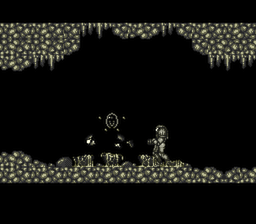 | 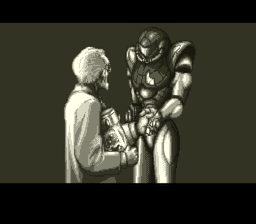 |
| A sweet surprise. | Delivering the goods. |
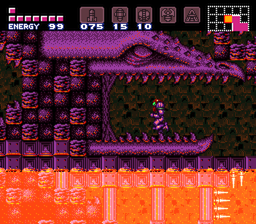 |
| On Ridley's Trail... |
Gameplay
Until the release of 1986's Metroid, platform games adhered to a very specific design: the completion of a given level through left-to-right progression. Upon starting up Metroid for the first time, players were presented with a wholly unfamiliar option: the ability to move left. Of course, this would prove a necessity, as players who chose instead to follow the instinctive desire to move right would soon find themselves unable to progress. Once players discovered they'd have to go left to pick up the Maru Mari (or "Morphing Ball," as we call it today), they soon realized they could go any direction they wanted, so long as they'd acquired the tools necessary to overcome whatever obstacles they'd discovered upon a given path.
Unfortunately, for all of Metroid's revolutionary design, it was largely hampered by the limitations of the NES's hardware: the caverns of Zebes, though containing a handful of aesthetically unique subsections, were rendered with such sameness that exploration became far more of a chore than a good time. Players would have to map out Zebes by hand if they were to have any chance at successfully navigating Samus through to the game's surprise ending. Of course, NES players unaccustomed to such creative involvement were more likely to turn back to Super Mario Bros than to bring out the graph paper.
Super Metroid is, for all intents and purposes, a remake of the original game. Not only does Samus return to Zebes, she also fights all of the same enemies and bosses as before (and then some!) Where it stands head-and-shoulders above its progenitor, however, is its inclusion of one simple feature: an on-screen, auto-updating map. Forget graph-paper: players could determine where they'd been - and more importantly, where they'd been stuck - with a quick glance at the screen.
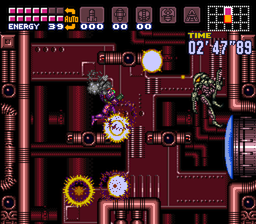 | 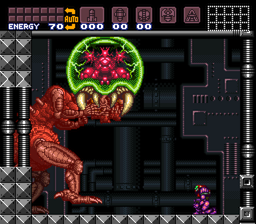 |
| Escaping Zebes! | An iconic conclusion. |
Earlier I lauded Super Metroid's "organic" gameplay without actually explaining this. I'll do that now. As I mentioned, the only thing stopping Samus from fully exploring Zebes is the limits of her inventory, which define her skill set. Consider, if you will, a game like Doom, where progression is reliant on the player's collection of a set of colored keys which open appropriately colored doors. As immersive as Doom felt in 1993, I always felt that this requirement of key-collecting was an arbitrary, offensively gamey mechanic. I felt that if Doom were real, and I really wanted to get through the red door, I could blast it open with my mini-gun. But the programmers at ID Software didn't account for the player's questioning this design element, and so we were all stuck hunting down keys. Not so for Super Metroid. Super Metroid's "keys" - those items that allowed us to get through red doors, climb back up impossibly tall shafts with no apparent platforms, and blast through apparently solid walls - aren't really keys at all. They're upgrades to Samus' arsenal. They're missiles. They're ice beams. They're speed boosters, grappling beams, hi-jump boots, and gravity suits. Super Metroid's keys allow players to progress not because they unlock doors, but because they give Samus the power to unlock doors without the key. Super Metroid's keys empower players by strengthening their connection to Samus through a shared sense of growth, earned through exploration. The fact that they double as weapon upgrades is just icing on the cake.
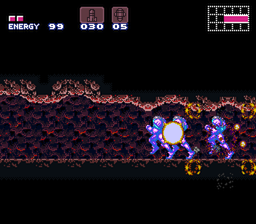 |
| Speed-running! |
Of course, no discussion of Super Metroid's gameplay would be complete without mentioning that other great impact on gaming the series pioneered: the speed-run. Average players, given no instruction, can probably make it through Super Metroid in 6-8 hours. I generally tend to take between 4-5, as I spend a lot of time trying to uncover hidden missile expansions and other secrets. Speed-runners have no time for listless exploration, as this is at odds with their primary objective: seemingly impossible completion times of an hour or less. They do this by combining a photographic memory of Zebes' layout with a complete understanding not only of Samus's abilities, but of the ways in which her body will react to specific elements within the game's world. In doing so, they tend to skip power-ups that most players consider essential to the game's completion, proving to the rest of us that these "essentials" really aren't so important after all. As they say, where there's a will, there's a way. Perhaps most importantly, true speed-runs are achieved not through cheating, but through countless hours of practice. To be a competitive speed-runner takes a dedication that goes well beyond obsession, and it's something that should be commended and celebrated.
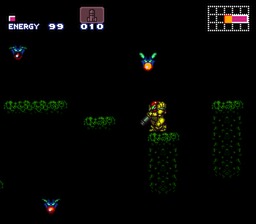 |  |
| Taking aim. | Slippery when wet. |
Graphics and Sound
 |
| The fallen soldier. |
On the NES, Zebes was a largely bland and monotonous location to explore. This was, unfortunately, less to do with a lack of imagination on the part of the game's artists and more to do with memory limitations on the system itself. The 16-bit incarnation of Zebes, on the other hand, is one of the most wholly believable sprite-based environments ever crafted. More so than relying on increased memory, resolution, and color depth, Super Metroid's artists have achieved this amazing makeover by infusing Zebes with a feeling of not only being alive, but lived-in, with an unrivalled attention to detail, to say nothing of the excellent character design and believable animation. Rain splashes down on the surface of the planet as Samus arrives, while large drops of water bounce back upwards as her boots slam down on the ground. Mutated flora dot the landscape, and a few friendly fauna are found in unlikely locations. A fallen warrior rests just outside Kraid's lair, fed on by a swarm of creatures that flee before Samus can arrive to shoo them away. Unnervingly, this encounter marks the only moment in the entirety of the game where players are given a respite from Super Metroid's sense of isolation.
Simply put, Super Metroid is dripping with atmosphere, and this isn't limited to the game's visual design. Much of what makes the game's aural presentation so brilliant is in its effective (though sparing) use of silence, which only enhances the claustrophobic loneliness of Samus's adventure. The sound design is further enhanced by Kenji Yamamoto and Minako Hamano's iconic score, which is at times mysterious, at times otherworldly, but always underscored by an unshakeable sense of dread.

Conclusion
I'm not alone in my belief that Super Metroid is the greatest game ever made, but of course, we as gamers can (and do!) argue back and forth all day over which game is truly deserving of such an accolade. What then, makes this particular one stand on the shoulders of so many others? Is it the the unbridled joy of exploration (which has been greatly reigned in for subsequent chapters of the series)? The unrivalled atmosphere of planet Zebes? Perhaps the fact that countless imitators have cropped up but have yet to top Super Metroid's purity of play? On one level, I think it's a combination of all of these; but more importantly, it's the fact that, nearly 20 years after its original release, Super Metroid still has secrets to uncover. And it's up to the player to decide when, and how, those secrets will come to light.
Cartridge label information
| Region | Country | Serial Code | notes | Scan |
|---|---|---|---|---|
| Americas | Canada | SNS-RI-CAN | regular release | link |
| Americas | USA | SNS-RI-USA | regular release | link |
| PAL | Australia | SNSP-RI-AUS | regular release | link |
| PAL | France and Netherlands | SNSP-RI-FAH | regular release | link |
| PAL | United Kingdom | SNSP-RI-UKV | regular release | link |
Do you have a label variant that is not listed above or a better quality copy? Read the Submission guidelines for cartridge label scans.
PCB Information
| ROM Chip ID | Region | Known Man. Dates | PCB Type | CIC | SRAM | Decoder/ Logic Circuit | Special Chips |
|---|---|---|---|---|---|---|---|
| SHVC-RI-0 (front) | Japan | 9352,9409 | SHVC-3A3M-01 | D411A | 64k | MAD-1 / SN74LS139N | - |
| SHVC-RI-0 (front) | Japan | 9409 | SHVC-BA3M-01 | D411A | 64k | MAD-1 | - |
| SHVC-RI-0 (front) | Japan | 9411 | SHVC-3A3M-01 | D411A | 64k | MAD-1 / SN74LS139N | - |
| SHVC-RI-0 (front) | Japan | 9421 | SHVC-BA3M-10 | D411A | 64k | MAD-1 | - |
| SPAL-RI-0 (front) | PAL | 9418 | SHVC-BA3M-10 | D413A | 64k | MAD-1 | - |
| SPAL-RI-0 (front) | PAL | 9419 | SHVC-BA3M-10 | D413A | 64k | MAD-1 | - |
| SPAL-RI-0 (front) | PAL | 9420,9419 | SHVC-BA3M-10 | D413A | 64k | MAD-1 | - |
Do you have a PCB with a different ROM chip ID, PCB type or manufacturing date? Read the Submission guidelines for PCB scans.
Box information
| Region | Country | Serial Code | notes | Front scan | Back scan |
|---|---|---|---|---|---|
| Americas | USA | SNS-RI-USA | regular release | link | link |
Do you have a box variant that is not listed above or a better quality copy? Read the Submission guidelines for box scans.
Screenshots
Screenshots (42)Cheats and Strategy Guides
In Depth Walkthrough - by catfish_82